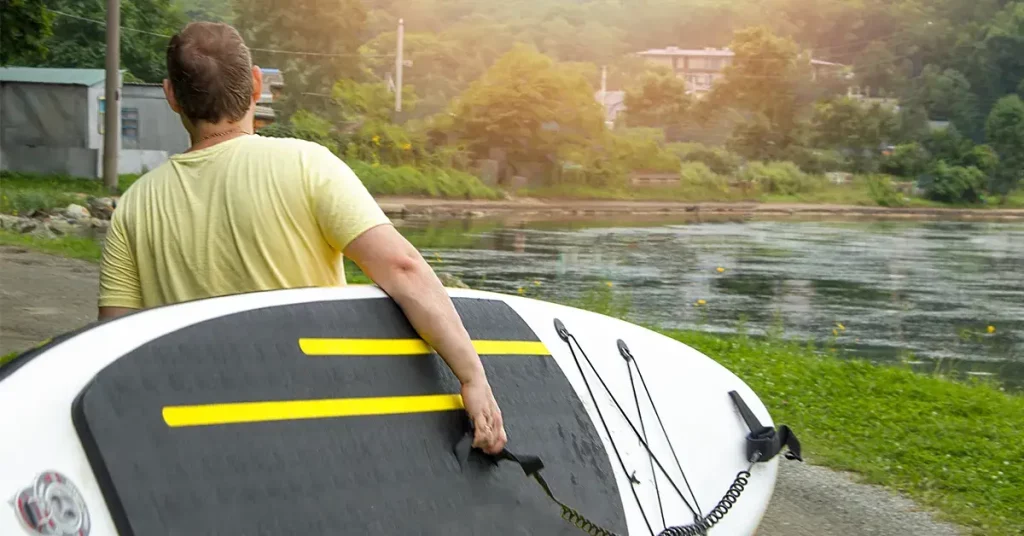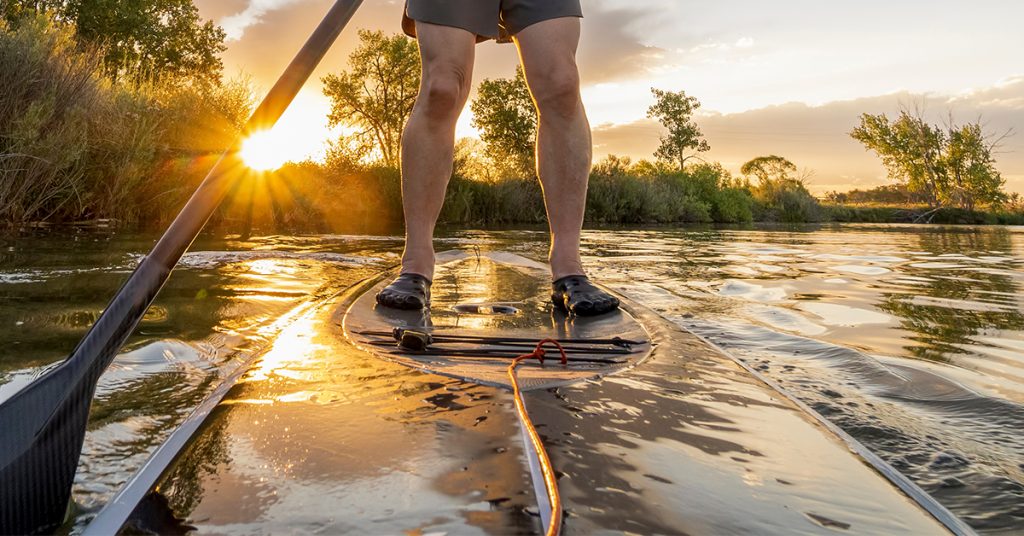If you love paddle boarding as much as I do, you’ll likely buy your own paddle board to use season after season. But in the off-season, storage may become an issue. Here are some ideas of how to store paddle boards for both inside and outside.
Paddle boarding is a popular water sport enjoyed in various settings, from calm lakes to choppy oceans. If you’re near a body of water, chances are you’ve seen people paddling around on their boards. Before you invest in a quality paddle board for yourself, you must consider how you’re going to store it when not using it. Proper storage will protect it from damage and allow you to enjoy paddle boarding for years to come.
Riders can store a Stand Up Paddle Board (SUP) indoors or outdoors, and there are different methods for each. We’ll explore the best way to keep your board, how to protect your board from the elements, and additional paddle board storage options you can use. If you’re considering a shopping trip to go look for the perfect paddle board for you, read this article first.
When To Cover a Paddle Board

Regardless of which route you take, the storage area should protect your board from these three things:
Sunlight
While we recommend paddle boarding on a sunny day, the ultraviolet rays can cause your board to warp or fade if left in direct sunlight for extended periods.
Moisture
There’s nothing worse than opening up your board bag and smelling mildew. If you store your stand-up paddle board in a humid or wet environment, it’s more likely to grow mildew and mold, which can cause damage to its shell.
Heat
Sources of extreme heat, like the sun, heaters or even fire pits, can cause damage to your paddle board’s core materials. While it’s not likely to melt, heat can cause the board to delaminate and blister.
With those points in mind, let’s look at the best way to store your board indoors and outdoors.
Where To Store Paddle Boards

Indoor storage is best if you have the extra space, live in a colder climate or don’t plan to use your board for a while. You can keep it in a garage, shed or inside your house. Some people even hang them on the walls as decorations. Conversely, if you live in a warm climate and want to use your paddle board more often, storing it outdoors means you can pick it up and go whenever you want. However, outdoor storage comes with a higher risk of damage.
Indoors
If you’re storing paddle boards indoors, there are a few things to consider.
Keep it Clean
Make sure the board is clean and dry before storing it. The dry plastic will prevent mold and mildew from growing on the board.
Find a “Home” for it
Locate a spot where the board won’t be in the way. A garage or shed is a good option, but you can also store your paddle board inside your house if you don’t have either of those. Just be careful not to damage the board or walls when moving it there.
Give Your Paddle Board Some Support
Support the paddle board so it doesn’t warp over time. You can prevent warping by hanging it on the wall or placing it on a shelf. If you’re hanging it on the wall, use padded hooks or straps, so you don’t damage the board.
Outdoors
If you decide on outdoor storage for your paddle boards, you’ll want to take a few precautions to prevent damage from the elements. As mentioned above, you’ll want to clean and dry your board entirely before storing it. Mold and mildew can cause permanent damage to paddle boards.
Throw it Some Shade
Find a shady spot out of direct sunlight. If there isn’t any shade available, suspending a water-resistant tarp over the board will provide adequate cover.
Again, a Little Support Goes a Long Way
Support your paddle board so it doesn’t sag. You can accomplish this task by placing it on a rack or against a wall. If you lean it against the wall, make sure it’s laying on its side or tail, and put some padding between where the board makes direct contact with the floor. Owners should note that propping up paddle boards isn’t a good long-term storage solution.
Cover Your Board
All riders will have to cover the entire board to protect it from the elements. If it’s going to rain, snow or be extremely hot, you’ll want to cover the board with a tarp, carry bag or SUP sock.
How to Store Paddle Boards

When storing your stand-up paddle board, you’ll need a way to support it so it doesn’t sag or warp. A few different options are available, including racks, mounts and suspension systems.
Leaning
While propping your paddle board against a wall is undoubtedly the easiest and cheapest option, it’s not the best way to store your board long-term. When SUP boards lean against a wall, the board’s weight can cause it to warp or sag over time. It’s OK for short-term SUP storage, but if you’re planning on storing your board for an extended time, it’s best to use one of the other storage methods mentioned.
Suspended
If you’re looking for a way to store your paddle board that doesn’t take up a lot of space, a suspension system might be the perfect solution. The board is hung from the ceiling using straps or hooks with this system. You can find these at a sporting goods store and online, or rig something up yourself using wide webbing straps.
Paddle board suspension systems keep the board safe and supported while freeing up space in your home, garage, or storage shed. Hang your board so that the hull is up and facing the ceiling to protect it. You can also add a soft material between the straps and the hull to relieve pressure points from the straps.
Different Types of Paddle Board Racks and Mounts

Here are some rack types for your paddle board:
Racks
A racking system is a great way to store your paddle board if you have multiple boards or you want to be able to access them easily. There are different types of racks available, including wall racks and free-standing racks.
- Wall-mounted racks: If you don’t have tons of room, a wall rack is an excellent choice since it allows you to store several boards in one location safely.
- Free-standing racks: Free-standing racks are an alternative to wall-mounted ones that give you the freedom to move the rack around to suit your space better.
Mounts
Mounts allow for paddle board storage in a specific spot, like on the side of your house or garage. There are different types of mounts available, including wall mounts and deck mounts.
- Wall mounts: Indoor wall mounts are a fantastic way to display your paddle board. Just be sure the mount is stable, and the wall can support the board’s weight.
- Deck mounts: Deck mounts keep your boards close to the water so you can grab them and go when it’s time to paddle. They’re also a good option if you don’t have much storage space.
When To Consider an Inflatable SUP Over a Hard SUP

No matter how hard we try to find a place for our paddle boards, sometimes there isn’t one. If you live in a small home or apartment, you might not have the floor space to store a hard stand-up paddle board. Inflatable stand-up paddle boards (iSUPs) are an excellent solution for small spaces since you can deflate and store them in a closet.
An inflatable paddle board is also a good choice for people who travel frequently. If you want to take your board on vacation but don’t want to deal with the hassle of transporting a hard board, an inflatable board will spare you the headache.
When deciding whether to get an inflatable SUP, there are a few things you’ll want to consider:
What Kind of Paddling You’ll Do
Consider the type of paddling you’ll be doing. Inflatable paddle boards are best suited for beginners and recreational paddlers because of their stability and flexibility. However, if you plan on doing any racing or SUP surfing, you’ll find that a solid board is a better performer.
Keep a Budget in Mind
Think about your budget. For the most part, iSUPs are less expensive than their hard counterparts. Additionally, inflatable boards are more durable, which means less costly repairs than a traditional rigid board.
Take Your Time into Account
Consider the effort you’re willing to put into inflating and deflating your board. If you don’t mind spending the time getting your paddle board inflated before paddling, an inflatable paddle board is a great option. But if you want to get on the water as quickly as possible, a hard SUP might be better.
Conclusion
There are many different ways to store paddle boards, and the best way for you will depend on your individual circumstances. Consider where you live, how often you use your SUP board and what type of storage space you have available. With these factors in mind, you’ll be able to find the perfect SUP storage method for your board. No matter where you live or what type of paddle board you have, there’s a paddle board storage solution that will work for you. After considering the tips above, you’ll be able to find the best way to store a paddle board correctly so it stays in excellent condition for years.



